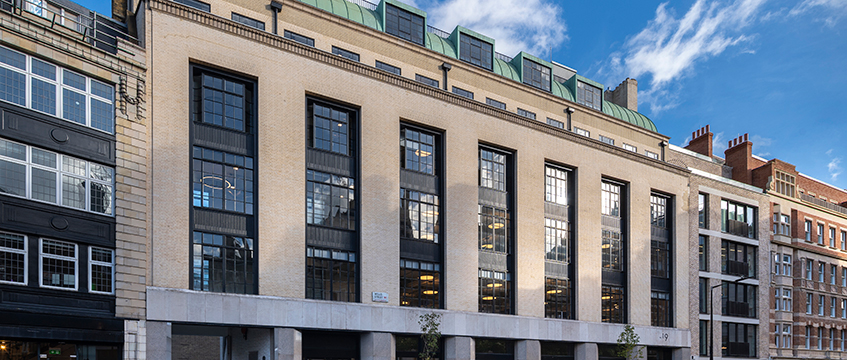GPE doubles down on flex office push
There is a first time for everything – especially in a real estate market as fast-moving as flexible offices. Advisers that helped GPE to buy British Land’s Storey site at 19-23 Wells Street, W1, last week reckon the deal was the first in the UK to see an owner-operator of flex space sell the building to a rival owner-operator.
In marking that milestone, the £19m trade underscores a new level of maturity in the market, as even the more traditional investors and developers such as GPE and British Land find ways to carve their own niche in flex.
It also speaks to GPE’s growing ambition for its fully managed portfolio, which it hopes to grow to more than 1m sq ft. And in putting a price on a flex-to-flex sale, says GPE investment manager James Harrop-Griffiths, “it’s proven evidence that valuers have been craving since flex and fully managed became a thing”.
There is a first time for everything – especially in a real estate market as fast-moving as flexible offices. Advisers that helped GPE to buy British Land’s Storey site at 19-23 Wells Street, W1, last week reckon the deal was the first in the UK to see an owner-operator of flex space sell the building to a rival owner-operator.
In marking that milestone, the £19m trade underscores a new level of maturity in the market, as even the more traditional investors and developers such as GPE and British Land find ways to carve their own niche in flex.
It also speaks to GPE’s growing ambition for its fully managed portfolio, which it hopes to grow to more than 1m sq ft. And in putting a price on a flex-to-flex sale, says GPE investment manager James Harrop-Griffiths, “it’s proven evidence that valuers have been craving since flex and fully managed became a thing”.
Second look
British Land first put the leasehold of 19-23 Wells Street up for sale last year. Having owned it for decades, the FTSE 100 REIT had run the space under its Storey flexible office brand since shortly before the onset of the Covid-19 pandemic. The GPE team looked at the building but did not bid.
“We were focusing on slightly larger lot sizes at the time,” says Harrop-Griffiths. “We had the [acquisition of] Courtyard [from the City of London Corporation] in the background as well and we had recently come off the back of [our] Soho Square [purchase]. It fell in between those stories.”
But earlier this year Harrop-Griffiths and colleagues reconsidered. Wells Street had not sold and GPE was able to start exclusive talks with British Land.
“We were getting some great leasing evidence in our Fitzrovia portfolio,” Harrop-Griffiths says. “We just wanted to see if we could get to a fair number with British Land. We approached them in June-July and in the end we reached a conclusion on the number.”
For chief financial and operating officer Nick Sanderson, the building’s proximity to other GPE sites in W1, such as Wells & More, Elsley House, Kent House and 7-15 Gresse Street, is all-important.
“The value of clustering has become clearer to us,” Sanderson says. “We don’t have enough space in Fitzrovia. We would like to have more so we can move customers around. And we think we can share the amenity across our buildings. It’s a real win for us.”
Doubling down
Sanderson had not – and still does not – expect GPE to buy many buildings that are already used for flex by their existing owners. “I think this is a relatively unusual one because you have got a flex operator that looks at the asset as being non-core,” he says of British Land’s attitude to Wells Street. “I don’t think there are many of those out there because most people, if they can, want to be growing their flex footprint. I think British Land probably do want to grow their flex footprint too – but on the campuses rather than in standalone units.”
That marks a differentiator in how the buyer and seller view their respective flex models, Sanderson adds.
“Most sophisticated real estate investors in the London office market see the flex opportunity,” he says. “But we’ve all weaved our way through. Initially [GPE was] doing fitted. Now we are going wholeheartedly on fully managed and we are looking to create clusters. What British Land is doing is focusing on Storey on its campuses. So this for them was a great asset but non-core, whereas for us it’s something that fits right into the core of what we are doing.”
Sanderson adds: “Flex means many things to many people. We are clear on what our offer is – we have been for a while, and we’re doubling down on that.
“It doesn’t look like everybody else’s. That doesn’t mean that one is better than the other. But ours is best for us, in terms of the micro locations in which we operate and the way we like to work.”
GPE said last month that it has a pipeline of £1.6bn of assets under active review or on its watchlist to buy, with other sites under offer. The company became a net buyer of London stock again this year, with chief executive Toby Courtauld saying the investment markets “remain favourable”.
With plenty of capital from its £350m rights issue in the summer, the coming months will show just how much larger the company’s clusters can get.
See occupational sales comparables for London W1 >>











